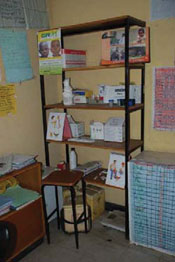8.5 Allocation of scarce resources
Health resources, such as financial or human resources, are always scarce whether you are working in developed or developing countries. Using resources to their best effect needs appropriate planning and allocation of resources to areas where they bring about the best outcomes. As a manager and healthcare provider in the Health Post you may be faced with a scarcity of resources (Figure 8.4) and need to make judgements to use your resources wisely so that you are able to satisfy the healthcare needs of the majority of your community (the principle of utility). As a manager and healthcare provider in your community, you may face ethical conflicts with regard to resource allocation.
Following some simple steps for decision making may help you resolve these difficulties (Box 8.2).
Box 8.2 Steps for decision making
- Identify the nature of the problem.
- Gather information and consider the possible ways to resolve the problem.
- Communicate openly and honestly with the community served.
- Involve an expert if possible.
- Implement the decision.

Case Study 8.4 Deciding priorities
Imagine that you are a Health Extension Practitioner in a rural area and you are planning to conduct a vaccination campaign and also a malaria control campaign. Both are necessary to improve the health of your local community, but there are only limited human resources available and it is not possible to do both of these campaigns immediately.
In this situation you need to decide: should you continue with the malaria campaign or the vaccination campaign, or share your resources in some way between both campaigns? There may be ethical principles that you can use to help you make your decision. Both campaigns may be beneficial for members of the community (beneficence), and none of the decisions seem to involve potential breaches of confidentiality. You may need to gather more information about the situation in order to be helped to make the correct decision.
Box 8.2 sets out the steps that can be used in decision making over ethical issues. How might following these steps help you to make the best decision about how to proceed in Case Study 8.4?
Following these steps might give you additional information that will help you take the decision. For example, you might find out that doing both campaigns using reduced resources would make both campaigns ineffective. When you consult both the community and the expert it might become apparent that you should give priority to the malaria control campaign, because this disease cannot wait. If it is not controlled speedily it may kill, or make many people in the community ill within a short period of time. Vaccination of children, on the other hand, can be postponed for another time because if the children are not vaccinated right away this will not necessarily bring about a disastrous health outcome. Remember that there will always be other people who can help you make important decisions, including ethical problems. Often it will help you if you ask your community what they prefer when there are options.
8.4 Shared decision making
